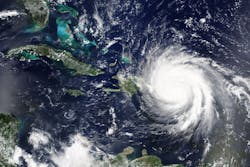Puerto Rico regulators on Friday issued final microgrid rules to help boost development, as the island continues to struggle to recover from last September’s island-wide power outage following Hurricane Maria.
The rules (CEPR-MI-2018-0001) arrived in a speedier fashion than the norm for energy regulation, with just five months between draft and finalization by the Puerto Rico Energy Commission (PREC).
Puerto Rico, a U.S. territory, is now ahead of most of the states in terms of presenting clear guideposts for the growing microgrid industry. It is also more desperate. On April 18 the central grid went down once again, plunging the entire island – about 3 million people — into darkness.
“The grid is not stable,” said Fidel Marquez, Commonwealth Edison’s senior vice president of governmental and external affairs and chief governmental and community relations officer, speaking earlier this month at Microgrid 2018 in Chicago. Marquez serves on the Transformational Advisory Council, tasked with advising the island’s utility board on modernizing its grid.
Marquez said that that on the mainland such widespread outages usually occur as a result of multiple “events,” but in this case it took just one — a truck severed a main utility line.
Pockets of microgrids kept power flowing to some homes and businesses. But the microgrids are still far too few. Many have been installed as temporary fixes until the central grid is restored. Humanitarian workers, non-profits and private companies have cited the need for regulatory clarity and planning to build out a robust network of permanent microgrids.
Tanuj Deora, executive vice president and chief content officer of the Smart Electric Power Alliance (SEPA), praised PREC’s work on the final rules, saying they address short-term needs, while providing “the type of guidance needed to set the groundwork for Puerto Rico to become a model of sustainability.” SEPA has been working on Puerto Rico’s restoration as part of the Build Back Better program.
Details on final microgrid rules
The new rules establish classes of microgrids, define types of generation they can use, and clarify the role of utilities and municipalities. Jared Leader, SEPA senior associate for utility strategy, issued a brief Friday describing the three classes of microgrids that can be developed under the rules.
- Personal microgrids, which will provide power to one or two consumers and can, with PREC permission, provide excess energy and grid services to neighboring customers
- Cooperative microgrids, which will serve three or more cooperative members, under two subcategories, small co-op microgrids of less than 250 kW or large co-op microgrids of more than 250 kW. Like personal microgrids, co-op microgrids can sell excess energy and services to others.
- Third-party microgrids, which have owners or operators who sell energy services to customers under rates approved by PREC and set on a project-by-project basis. Owners can earn a reasonable rate of return for the first three years of operation.
For now, only off-grid microgrids can be built — meaning personal and cooperative microgrids. That will change when the island utility, Puerto Rico Electric Power Authority (PREPA), establishes interconnection rules, paving the way for third-party microgrids. PREC ordered the utility to do so within 120 days
The rules define ‘renewable microgrids’ as those that can generate 75 percent of their energy from renewables — solar, wind, geothermal, hydropower or biomass – and 25 percent from fossil fuels. A combined heat and power (CHP) microgrid must produce at least half of its total energy from the useful thermal energy captured from the plant. A hybrid microgrid may incorporate CHP and renewable systems, but the non-CHP system must generate 75 percent of its energy from renewables.
Municipalities may enter into contracts with a third-party provider to develop microgrids — or they may develop them on their own. PREC also allowed the island utility to develop microgrids, under the new rules.
“In the longer term, microgrid development will need to be incorporated into a customer-centric Integrated Resource Plan for Puerto Rico’s energy future,” Deora said. “The full implications of this are yet to be determined, but SEPA looks forward to working with all parties to ensure these systems can efficiently interconnect to the grid, provide financial sustainability for all parties and become an engine for economic growth.”
Toll of power outage still unknown
Jake Rios Torres, 9, watches as military and government aid workers deliver food and water. Hurricane Maria destroyed his home in the mountains around Utuado, Puerto Rico. Courtesy of U.S. Air Force photo by Master Sgt. Joshua L. DeMotts
The new rules come as Puerto Rico nervously eyes the start of the next hurricane season, which begins June 1. Pockets of the island still remain without power. It’s been particularly difficult to restore within rugged mountain terrain.
The full human cost of the Hurricane Maria power outage – the second longest on record – has yet to be tallied, according to William Heegaard, Founder of Footprint, which has been assisting in bringing solar plus storage microgrids to the island as part of a humanitarian effort.
Heegaard, who also worked as a paramedic on the island, described the desperation that occurred when people could not refrigerate their medications. When deaths occurred as a result, they were not recorded as caused by the power outage
“The medical examiners say they died out of diabetic complications. Those numbers do not get categorized into death-from-hurricane,” he said, speaking at Microgrid 2018. “We need to humanize this discussion. These are American citizens, and we have left them.”
At the same time, Heegaard said he was encouraged by the ingenuity shown by Puerto Ricans. Their resourcefulness, combined with advancements that make simple microgrid installations easy to do, bode well for the island, he said.
“American citizens in Puerto Rico can wire a solar panel to a battery bank better than most of us in this room” — Heegaard
“American citizens in Puerto Rico can wire a solar panel to a battery bank better than most of us in this room,” he told the audience. “Exciting things are going on, things to be hopeful for.”
He noted that “this is one of the first large scale humanitarian disasters that brought immediate attention to renewable energy.” Three hundred thousand people fled the island, but “the rest who stayed are asking for Tesla.”
Share your thoughts about Puerto Rico’s final microgrid rules. Join our LinkedIn group, Microgrid Knowledge.







